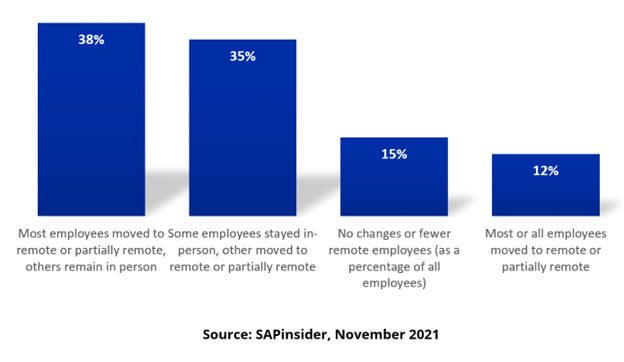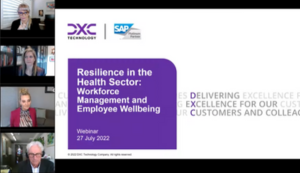Hybrid Workforces Bring Unique Payroll Challenges
Meet the Experts
Many companies have moved back into their offices, but it takes only a quick look at job boards to see that remote work still persists at a much higher rate than it did before the pandemic. Many positions will have the option of being remote or partially remote going forward, bringing about hybrid workforces. This creates unique human resources (HR) challenges, especially for payroll.
In our recent HR technology research, 85% of those surveyed experienced at least some segment of their employees moving to remote work.

While most companies are moving to at least partial remote work, only a small segment are going fully or partially remote for all employees. This means companies are now dealing with hybrid work scenarios — some employees fully remote, others fully in-person, and some a mix of remote and in-person. That mix of locations means organizations need technology that enables employees to access their HR data and processes from inside and outside of the office.
The Impact of Hybrid Workforces on Payroll
Remote and hybrid workforces are bringing unique challenges on the payroll side, says Rajamma Krishnamurthy, Senior Director of HR Technology at Microsoft. If a company hires a new employee in a new country or state, its payroll system needs to be able to accompany that.
“Nobody fully understands what hybrid workforces mean in terms of associated payroll taxes,” says Krishnamurthy. “But SAP is in a unique position to know and understand that. You have to trust your payroll engine to know the local nuances”
She explains that SAP’s payroll engine, with its many built-in localizations, is one of the reasons they prefer it to competitors. Still, they says more can be done to adapt payroll systems to the current hybrid workforce’s reality.
“I’d like to see payroll be modernized,” says Krishnamurthy. “Mobility creates a challenge. Some employees may want to work two weeks out of Colorado and want to go to Hawaii in December.”
Localization is just one of the payroll challenges that arise in the face of hybrid workforces. Payroll systems themselves haven’t undergone the development and innovation that other areas of HR technology have experienced. Even SAP SuccessFactors Employee Central Payroll is just a cloud-hosted version of on-premise SAP Payroll.
Frankly, the hesitance to innovate payroll stems in large part from companies taking the “if it ain’t broke, don’t fix it” mentality, and for good reason. The fastest way to make employees unhappy is to mess up payroll, and any payroll transformation presents at the least the idea of that possibility.
However, Krishnamurthy and other forward-thinking HR leaders know that payroll systems could do more for them and would welcome updated technology that could better handle the added challenges of remote and hybrid workforces.
What This Means for SAPinsiders
Approach HR transformation as if you need to meet the requirements of remote employees. Companies that transitioned more to remote work tend to have employees who are happier with their HR processes and technologies. When implementing a process or software for a remote worker, it’s a must to provide things such as self-service — and that’s a key element to achieving better employee experiences. If you are dealing with a hybrid workforce, addressing the needs of the remote workers is likely to improve experience for all employees.
Ensure talent acquisition is up to speed on payroll localization. If your company is branching out with remote employees and hiring people in new locations, that may cause a delay depending on what systems you have in place. Recruiters need to know this so they can communicate it to candidates and new hires and reduce any potential confusion that could diminish the candidate experience.









